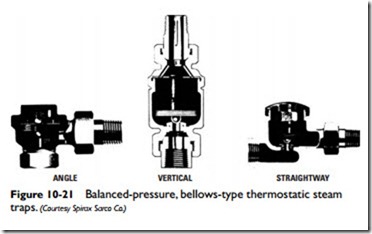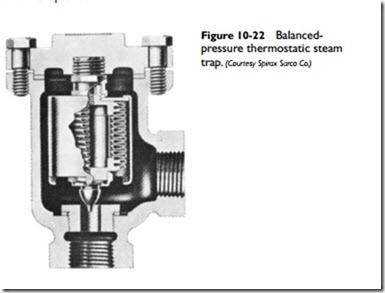Balanced-Pressure Thermostatic Steam Traps
As shown in Figure 10-21, the principal parts of a balanced-pressure thermostatic trap consist of a flexible bellows, a valve head, and a valve seat. The bellows is partially filled with a volatile fluid and hermetically sealed. The fluid sealed in the bellows has a pressuretemperature relationship that closely parallels, but is approximately 10F° below , that of steam. When the condensation surrounding the bellows reaches approximately 10F° below saturated steam pressure, the fluid inside the bellows begins to build up pressure. When the temperature of the condensation approaches that of steam, the pressure inside the bellows exceeds the external pressure. This pressure imbalance causes the bellows to expand, driving the valve head to its seat and closing the trap (see Figure 10-22). When the condensation surrounding the bellows cools, the vaporized fluid condenses and reduces the internal pressure. The reduction of internal pressure causes the bellows to contract, opening the trap for discharge.
A balanced-pressure thermostatic steam trap is vulnerable to water hammer and corrosive elements in the condensation. The latter problem can be handled by fitting the trap with anticorrosive internal components. On the plus side, this type of trap has relatively large capacity and high air-venting capability. It is completely self-adjusting within its pressure range.
Additional information about balanced pressure steam traps can be found in Chapter 2 (Radiators, Convectors, and Unit Heaters)” in Volume 3.
Maintenance
These valves are factory sealed and no repair parts are available. If defective, they must be replaced. The valves must be completely isolated from both the supply and return lines before removal for replacement.

